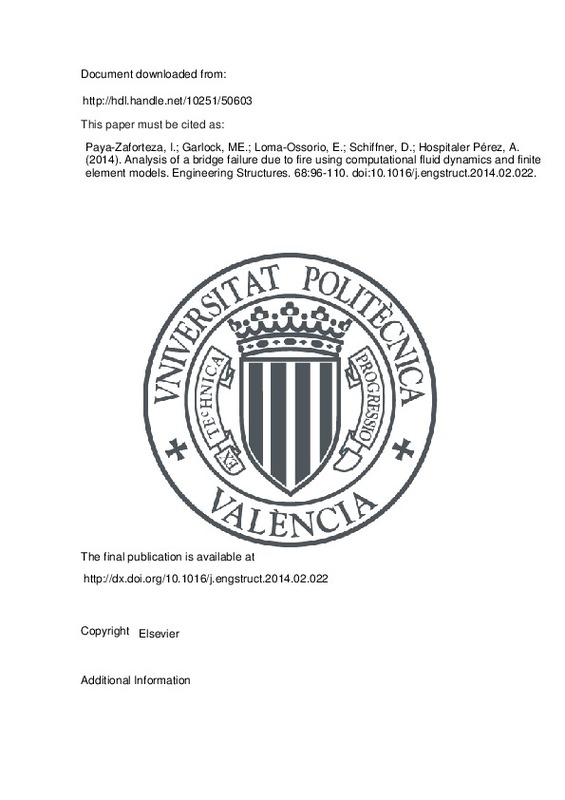JavaScript is disabled for your browser. Some features of this site may not work without it.
Buscar en RiuNet
Listar
Mi cuenta
Estadísticas
Ayuda RiuNet
Admin. UPV
Analysis of a bridge failure due to fire using computational fluid dynamics and finite element models
Mostrar el registro sencillo del ítem
Ficheros en el ítem
| dc.contributor.author | Alós Moya, José
|
es_ES |
| dc.contributor.author | Paya-Zaforteza, Ignacio
|
es_ES |
| dc.contributor.author | Garlock, Maria E.M.
|
es_ES |
| dc.contributor.author | Loma-Ossorio, Eduardo
|
es_ES |
| dc.contributor.author | Schiffner, Daniel
|
es_ES |
| dc.contributor.author | Hospitaler Pérez, Antonio
|
|
| dc.date.accessioned | 2015-05-21T08:06:40Z | |
| dc.date.available | 2015-05-21T08:06:40Z | |
| dc.date.issued | 2014 | |
| dc.identifier.issn | 0141-0296 | |
| dc.identifier.uri | http://hdl.handle.net/10251/50603 | |
| dc.description.abstract | Bridge fires are a major concern because of the consequences that these kind of events have and because they are a real threat. However, bridge fire response is under researched and not covered in the codes. This paper studies the capabilities of numerical models to predict the fire response of a bridge and provides modeling guidelines useful for improving bridge design. To reach this goal, a numerical analysis of the fire of the I-65 overpass in Birmingham, Alabama, USA in 2002 is carried out. The analyses are based on computational fluid dynamics (CFD) for creating the fire model, and finite element (FE) software for obtaining the thermo-mechanical response of the bridge. The models are validated with parametric studies that consider heat release rate of the spilled fuel, discretization of the fire temperature in the transition from CFD to FE modeling, and boundary conditions. The validated model is used in a study to evaluate the influence of fire scenario (CFD versus standard fires), and live load. Results show that numerical models are able to simulate the response of the bridge and can be used as a basis for a performance-based approach for the design of bridges under fire. Additionally, it is found that applying the Eurocode standard and hydrocarbon fires along the full length of the bridge does not adequately represent a real bridge fire response for medium-long span bridges such as this case study. The study also shows that live loads essentially do not influence the response of the bridge. (C) 2014 Elsevier Ltd. All rights reserved. | es_ES |
| dc.description.sponsorship | Funding for this research has been provided by the Spanish Ministry of Science and Innovation (research project BIA 2011-27104) and the Universitat Politecnica de Valencia (Research and Development Support Program PAID-06-11). Funding has also been provided to Dr. Maria Garlock by the National Science Foundation (NSF) under award number CMMI-1068252. The authors are grateful to R. King from the Federal Highway Administration of the USA, J. Black and T. Colquett from the Alabama Department of Transportation, J. Glassman from Princeton University, J.V. Aguado from Ecole Centrale de Nantes and to J. Hidalgo from the University of Edinburgh for all the information and support provided. All opinions expressed in this paper are the authors' and do not necessarily reflect the policies and views of the sponsors. | en_EN |
| dc.language | Inglés | es_ES |
| dc.publisher | Elsevier | es_ES |
| dc.relation.ispartof | Engineering Structures | es_ES |
| dc.rights | Reserva de todos los derechos | es_ES |
| dc.subject | Fire | es_ES |
| dc.subject | Bridge | es_ES |
| dc.subject | CFD, Steel girder bridge | es_ES |
| dc.subject | I-65 overpass | es_ES |
| dc.subject | Performance-based design | es_ES |
| dc.subject.classification | INGENIERIA CARTOGRAFICA, GEODESIA Y FOTOGRAMETRIA | es_ES |
| dc.subject.classification | PROYECTOS DE INGENIERIA | es_ES |
| dc.subject.classification | INGENIERIA DE LA CONSTRUCCION | es_ES |
| dc.title | Analysis of a bridge failure due to fire using computational fluid dynamics and finite element models | es_ES |
| dc.type | Artículo | es_ES |
| dc.identifier.doi | 10.1016/j.engstruct.2014.02.022 | |
| dc.relation.projectID | info:eu-repo/grantAgreement/MICINN//BIA2011-27104/ES/DEFINICION DE CONDICIONES DE MONITORIZACION, ENCAPSULADO Y FIJACION DE SENSORES OPTICOS PARA MEDIR TEMPERATURAS Y DEFORMACIONES EN ESTRUCTURAS SOMETIDAS A ALTAS TEMPERATURAS/ | es_ES |
| dc.relation.projectID | info:eu-repo/grantAgreement/NSF//1068252/US/Collaborative Research: Fire Damage Mitigation and Post-Fire Evaluation of Steel Girder Bridges/ | es_ES |
| dc.relation.projectID | info:eu-repo/grantAgreement/UPV//PAID-06-11/ | es_ES |
| dc.rights.accessRights | Abierto | es_ES |
| dc.contributor.affiliation | Universitat Politècnica de València. Instituto de Ciencia y Tecnología del Hormigón - Institut de Ciència i Tecnologia del Formigó | es_ES |
| dc.contributor.affiliation | Universitat Politècnica de València. Departamento de Ingeniería de la Construcción y de Proyectos de Ingeniería Civil - Departament d'Enginyeria de la Construcció i de Projectes d'Enginyeria Civil | es_ES |
| dc.description.bibliographicCitation | Alós Moya, J.; Paya-Zaforteza, I.; Garlock, ME.; Loma-Ossorio, E.; Schiffner, D.; Hospitaler Pérez, A. (2014). Analysis of a bridge failure due to fire using computational fluid dynamics and finite element models. Engineering Structures. 68:96-110. https://doi.org/10.1016/j.engstruct.2014.02.022 | es_ES |
| dc.description.accrualMethod | S | es_ES |
| dc.relation.publisherversion | http://dx.doi.org/10.1016/j.engstruct.2014.02.022 | es_ES |
| dc.description.upvformatpinicio | 96 | es_ES |
| dc.description.upvformatpfin | 110 | es_ES |
| dc.type.version | info:eu-repo/semantics/publishedVersion | es_ES |
| dc.description.volume | 68 | es_ES |
| dc.relation.senia | 265781 | |
| dc.contributor.funder | Ministerio de Ciencia e Innovación | es_ES |
| dc.contributor.funder | National Science Foundation, EEUU | es_ES |
| dc.contributor.funder | Universitat Politècnica de València | es_ES |
| dc.contributor.funder | University of Edinburgh | es_ES |







![[Cerrado]](/themes/UPV/images/candado.png)

